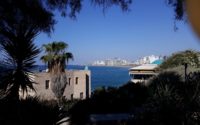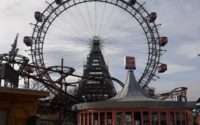An Unexpected Development
20.09.2017
My second visit to Kraków, Poland’s ancient capital and a city where my father lived for a few years as his father was stationed here during his army service in the 20th Kraków infantry regiment. The weather forecast for Kraków for the rest of the week is rain, with the dry weather returning when I board the train to Wrocław, my next destination. When it rains in Kraków that’s the time to soak up some Polish culture and the ‘Getyourguide’ app has a number of suggestions. I opt for a Chopin concert for Saturday evening. I would also like to make a visit to Częstochowa ( pronounced Chen-sto-hova ) to the Jasna Góra Monastery where the painting of the Black Madonna is hung. Having visited Auschwitz, and the splendid saltmines Wieliczka ( pronounced Vee-el-eechka ) on a previous visit, the Monastery is another of the many landmarks in the region.
I receive an email from a Kraków firm of lawyers, Lexmotion, who say that I’m eligible for Polish citizenship subject to certain documentary criteria. It seems siblings and children are also eligible. I have arranged an appointment for Friday morning – at least it will be indoors.
Just a word of warning if you visit Kraków or any other major city, especially if you arrive by train and hail a taxi – always look for a company sign, as Kraków is awash with unregulated cabs. The ride to the place I’m staying costs 16 złoty (around €5) and I learned later from the receptionist that some people had been charged as much as €50 for the short cab ride from the station to the hotel. I recommend you download an app such as ‘Taxify’ or an equivalent and get an idea how much you can expect to pay.
Evidence of Kraków’s historical connections to the Caucuses region in south eastern Europe is marked with such places as Georgian Restaurants, in one of which I spend a pleasant evening, It would be a good idea if restaurants would allow you to go for walk and come back for dessert. Georgian wine tastes excellent, for me anyway as I am no wine connoisseur.
I can still remember a few places from my previous visit to Kraków including the Cloth Hall in the middle of Rynek Głowny which means the Large Square (selling even more Jesus, Mary and John Paul II trinketry) alongside the impressive Church of St.Mary. I’m passing the church on the hour and the world famous trumpet call (Hejnal) is playing: https://en.wikipedia.org/wiki/St._Mary%27s_Trumpet_Call This tradition dates back centuries. Incidentally it’s as if the last Pope ever was John Paul because there is not a picture of Pope Francis to be seen anywhere. The lighting display in the Cloth Hall makes it a very impressive sight by night.
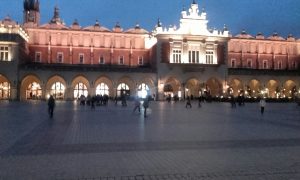
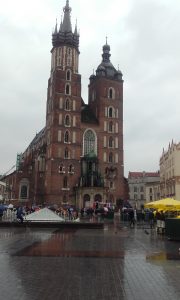
21.09.2017
Perhaps it might be the rain, a bit of tiredness, or being on the move to explore things, but I feel a bit flat this morning,but that evaporates once washed and freshened. On the lift to breakfast is a Japanese man with no arms or legs in an adapted wheelchair accompanied by two carers. I bid them all good day and the feeling of disinterest leaves me immediately. Inwardly I thank this unfortunate man.
What do you do in Kraków in the rain when you have already seen the usual tourist things? Wandering around, I pass a local market and go in. An opportunity to practice my limited Polish as I ask for two William pears. That works out fine – I have pears and not cauliflower.
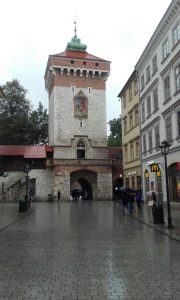
I still haven’t found a guided tour to Częstochowa and the rain is getting heavier. In one tourist office I ask if they know how to go about finding out where a deceased relative is buried and explained the situation about my grandmother. They suggest I try the local council office in Żory (where she died) which is near the city of Katowice. Time is not on my side with this visit to find my grandmother’s grave. It will take a separate visit based in Katowice to make any headway.
The next tourist place I visit has a place for Saturday but there is no guarantee I’ll be back in time for the Chopin concert the same evening. That is soon remedied through the ‘Getyourguide’ app when I am able to bring the Chopin concert forward to tomorrow evening with a simple click and returned e-mail confirmation. Częstochowa booked and no clock-watching necessary.
Still pouring and I’ve had one soaking today of those parts of clothing not protected by this wonder blue raincoat. This hotel does veggie dishes and at the very least I’ll be dry. Something different from pierogi, meat poultry and so on – fried black lentil balls with roasted peppers sauce and green salad. It is one of the most delicious things I’ve tasted. I’m satisfied and not full up. I’d be happy to have that again.
22.09.2017
These past two weeks have sprung a few surprises so you never know what’s next. I have an appointment with a law firm here in Kraków that specialises nationality law.
It turns out that I have all the evidence I require within my father’s war record to qualify for Polish citizenship subject to other of my own documentation being submitted. This means that the search for my father’s birth certificate ends, and it turns out that it would not have mattered if my grandfather had a box full of Virtuti Militari medals (awarded for bravery, the equivalent of the Victoria Cross) either. Children also qualify through their grandfather once I acquire it. It costs, but as things stand and once the emotion of the thing is wiped away, it should be a positive move. I cannot believe it was that easy. This law firm is dealing with applications from thousands of British citizens with backgrounds such as mine because of Brexit and surprisingly, with Americans because of Trump. The process should take a matter of months. On my return back to the city centre on the tram, I disembark at the nearest stop to the famous Wawel Castle and walk there just to reflect on the morning’s meeting. The castle is central to Polish history https://wawel.krakow.pl/en and so it seems the perfect location to digest what Polish citizenship will mean for me. It’s one thing to find information about lost family such as mine, but I think it is incomplete without visiting the places they may have lived. Furthermore, I believe it should be done with the minimum amount of emotion. Taking Polish citizenship means accepting the country’s history good and bad in equal measure without judging. Poles weren’t always the martyrs, they knew how to dish out the repression too when it suited them.
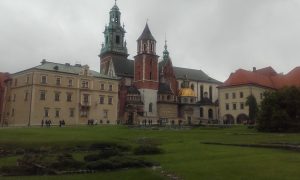
The last time we were in Kraków the old Jewish Quarter of Kazimierz was in the process of being renovated. Today it is about 75% complete and you can still distinguish some of the blocks as they would have been before 1939, full of people. The synagogues have all been refurbished and it was heartening to see parties of Jewish people, some wearing their orthodox attire touring around, some obviously from Israel come to explore their roots. What a shame then that some moron had seen fit, at some time in the past, to daub a wall with ‘JUDE GANG’ German for ‘JEWS GO AWAY’. It’s all the more sickening that this as probably written by a Polish neo-Nazi.
And so to the Chopin piano concert with my Polish identity fortified (chuckles to himself) and it is an enjoyable experience. So there you have it; the finesse of Chopin’s ‘Polonaise’ merges with the foot-stamping ‘Roses O’ Prince Charlie (gosh, yes he was Polish!) energy of the Corries. Polish-Scottish; a mixture of cultures made in heaven! How can I possibly lose?
23.09.2017
Raining again, so an ideal day to sit in a minibus for the two hour journey to Częstochowa to visit Jasna Góra Monastery where the portrait of Our Lady of Częstochowa is located. My fellow tourists are a couple from the Phillipines, who introduce themselves as Lyn and Roger rather than their Spanish Christian names. We have an interesting chat and I learn much about the Philippines. I had no idea that it was 95% Christian and it is the only country in that part of the world that does not use chopsticks to eat meals. Who would have believed that ?
Częstochowa itself is not a very attractive place with huge flat roofed Soviet style monolith housing blocks everywhere. I guess the city was totally devastated during the war. The monastery itself is located just outside the city on a hill, ‘Bright Hill’ is the translation of Jasna Góra.
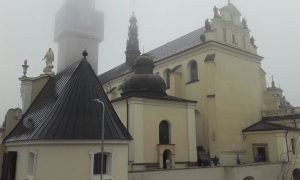
What must this place be like in the high season? It’s busy just now and the rain is still falling. Our guide gets right down to it and we are in the room where the Kings of Poland were crowned. There are portraits of some of them and other royal scenes. The monks were able to hide the icon from the Nazis during the war. The ordinary German soldier did not attempt to loot anything like crafted tables, the guide reckons, out of an appreciation of art. The Nazis would have been another matter. The artist who painted the portrait of Our Lady of Częstochowa is unknown, but carbon dating suggests it was completed sometime between the 8th and 12th century. It was brought to Poland from Ruthenia, then a province of Poland, by Prince Władysław of Opole, who later founded the Jasna Góra Monastery; entrusting care of the portrait to a group of Pauline monks from Hungary. It’s style is Byzantine, so its origins may lie in the Balkans or Greece. The image was desecrated by Bohemian iconoclasts called Hussites in the mid 15th century who slashed it with swords. The slash marks on the face of the portrait were added to commemorate the vandalism when it was later renovated. After the monastery held out against an invading Swedish army which was later pushed out of Poland, King Jan Kazimierz when crowned King in Lwów appointed Our Lady to be Queen of Poland in thanksgiving for the victory at Jasna Góra. A crown and jewelled robes were added, but not onto the painting but as a kind of removable overlay which is why you can see different crowns and robes and sometimes none during changeovers, depending on the occasion such as the visit of a Pope or because they just feel like a change.
Moving through other rooms and vestries, you arrive at the chapel where the portrait is hung. It is quite a moving moment even for a not very religious person as myself. I stopped to think of my father, my grandparents and my aunt for whom this would have been a moving moment had they ever got here. I thought of my mother too as she was always fascinated by the story and would have liked to have accompanied my father here had it been possible (NB I later found out that they did).
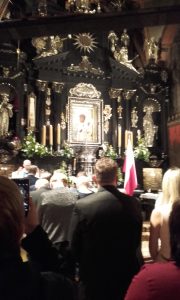
One thing that strikes me is that this kind of devotion has gone from the west. It may be as a result of Turkish and therefore Muslim invasions, the partitions of Poland, the horrors of the war and the Stalinist persecutions that at times this is all the people have had to unite them. The people in this part of what we used to call eastern Europe identify with their Christian heritage and rebuke us in the west who have, in their opinion allowed fundamentalist Muslims to make demands that water down Christian identity and dictate the terms of respecting their Muslim identity. It’s my own experience that the majority of Muslims in the west do not make such demands. But as usual it is the troublemakers that make the headlines. One thing that I must stress is that Poles do not regard this place for Polish Catholics alone but for all Poles. It is a mark of nationhood not religion.
Finally the term ‘Black Madonna’ is a derogatory one which the Nazis used to mock the colour of the portrait. Poles never use that term.
24.09.2017
The final day of Kraków for this trip and it’s dry; so perhaps an opportunity to take a leisurely stroll through the Old City, rather than running for cover all the time, usually into a relatively expensive coffee shop or ‘kawiarnia’ as they are know as here.
I’m pleased I was able to get to Jasna Góra yesterday and saw the icon of Our Lady as I appreciate fully the role Christianity has had in Poland’s history.
In Rynek Mały (Small Square) a market is in full swing with food and non-alcohol, no I think alcohol is on offer – it is 10.30. Rynek Główny is in full motion and the tourists part company with their złoty on overpriced stuff because they say ‘Polska’ or ‘Kraków’ in bold red and white. All oblivious to the fact that if they had kept going a little bit further off the square they would have bought the same stuff for a lot less.
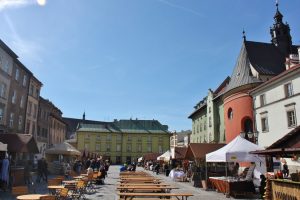
Back to Rynek Mały and the smells are irresistible and a couple of circuits round the food stall and it’s sausages, mustard, stir fried vegetables and bread – absolute magic.
Schindler’s Factory for a guided tour. To clarify, the factory is less to do with an exhibition of tools and other materials from the war and more to do with the history of Kraków from the 1920’s and through the war years focussing mostly on the plight of the Jewish community. The Nazis set about transforming Kraków into a German city, the most easterly of the Third Reich, as they would have described it. Street signs in Polish and German are on exhibit mostly announcing Jewish prohibitions, notices and pictures of summary executions, carried out as reprisals. Examples of artefacts of what would have been in Schindler’s factory are exhibited as the originals are long gone. But the conditions the Jewish people had to endure are well highlighted and the tombstone nature of the ghetto wall suggest death – all horrifically implied as stone metaphors. There are however pots and pans on display and an original bogey and wheelbarrows used to transport stones. People pushed and loaded these things until they dropped dead. A list of all who were saved by Oskar Schindler is inscribed on a circular wall and towards the end of the tour further inscriptions on the wall recounting testimonies from all sides. Photographs of those who survived, taken in later years, line the walls towards the end of the tour.
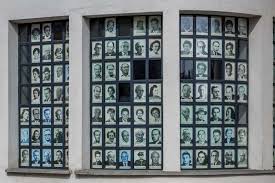
What I did not realise was that the building was originally leased to Schindler as a sort of franchise as the Nazi regime held control over all such activity. However, Schindler’s connections were such that he was able to do a deal to buy the building and business outright, thus he had greater control over saving all the Jewish people he did. Schindler was able to save Jews from the notorious Plaszków concentration camp run by the sadistic Amon Goeth buy bribing him to hand over great numbers to Schindler’s operations in his factory.
Tomorrow I head for Wrocław, which was known as Breslau before WW2 and was an important German city. Between 1945 and 1947, it underwent a massive population transfusion.
End
